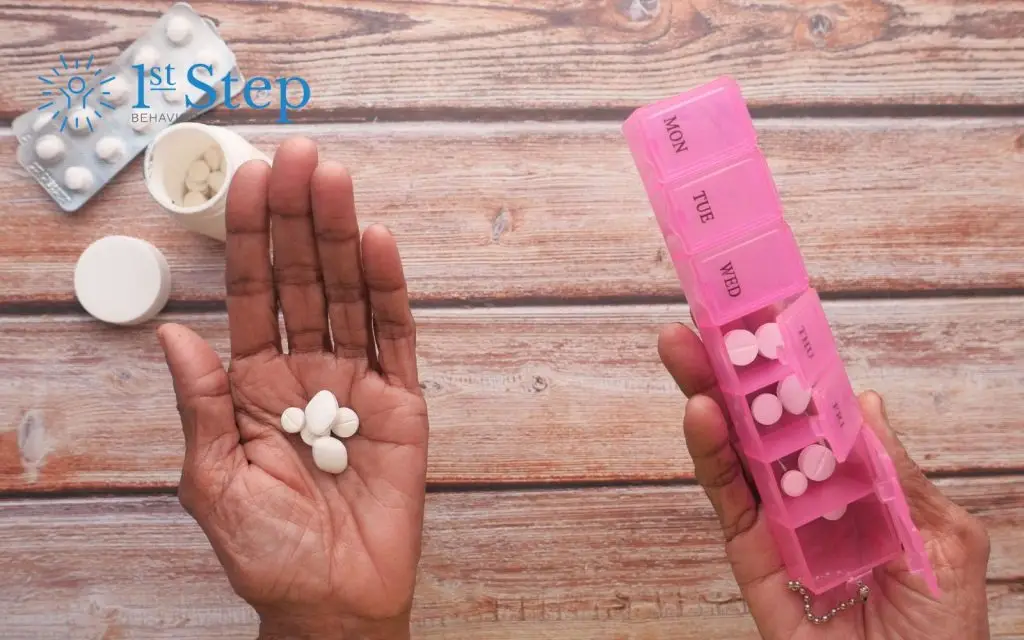Millions of people in the United States and around the world take prescription stimulant medications. Many people take these medications to manage the symptoms of attention-deficit hyperactivity disorder (ADHD). People may also take them to treat narcolepsy and other conditions.
Some people may abuse prescription stimulants. People may take higher doses than prescribed or take them recreationally. Stimulant abuse can have serious short and long-term risks, including addiction.
This article will explore two common prescription stimulant drugs: Ritalin and Adderall. You will learn:
- The effects and risks of these drugs
- The differences between Ritalin and Adderall
- How to recognize and treat stimulant addiction
- Where to find comprehensive treatment and recovery support
If you or someone you love struggles with stimulant abuse, you are not alone. Find comprehensive treatment and compassionate support at First Step Behavioral Health. You may learn about our programs or schedule an intake appointment by contacting our specialists now.
The Effects and Risks of Ritalin
Ritalin is the brand name for a prescription stimulant called methylphenidate. Ritalin works by stimulating central nervous system (CNS) activity. It increases norepinephrine and dopamine in the brain. This can reduce common symptoms of attention deficit hyperactivity disorder (ADHD) and other conditions.
People who take Ritalin as prescribed are unlikely to develop serious side effects. However, some people abuse this drug by:
- Taking larger doses
- Taking doses more often
- Taking Ritalin differently than prescribed, such as crushing and snorting pills
- Taking Ritalin without a prescription
People may take Ritalin recreationally for its stimulant effects. In addition to increased focus and more energy, Ritalin abuse can cause unwanted side effects, including:
- Fatigue
- Dizziness
- Anxiety
- Headache
- Reduced appetite
- Weight loss
- Trouble sleeping
- Depression
- Excessive sweating
- Dilated pupils
- Agitation
- Mood swings
People who abuse Ritalin frequently may develop physical dependence and addiction. People who become addicted to an ADHD medication typically require treatment to quit and avoid relapse.
The Effects and Risks of Adderall
Adderall is a prescription stimulant medication that contains amphetamine and dextroamphetamine. It is available in immediate-release tablets and Adderall XR (extended-release) tablets.
Adderall increases CNS activity and stimulates the brain’s dopamine and norepinephrine systems. People may take Adderall to treat ADHD symptoms and other conditions.
People taking Adderall as prescribed are unlikely to develop physical dependence or addiction. However, people who abuse it may experience unwanted side effects, including:
- Decreased appetite and weight loss
- Dry mouth
- Rapid heart rate
- Insomnia
- Seizures
- Constipation
- Mood changes
- Slowed speech
- Headache
- Anxiety
- Tremors
- Nausea
People may experience significant mental health and behavioral changes related to Adderall abuse. They are also at risk of developing physical dependence.
Ritalin vs Adderall: What is the Difference?
Ritalin and Adderall are similar in many ways. They have similar common side effects and are both controlled substances with a risk of physical dependence.
There are some important differences between Ritalin and Adderall. Here is an overview of these differences.
Onset
Ritalin’s effects typically start sooner than Adderall’s effects.
Peak effects
Ritalin immediate-release tablets’ effects peak at around two hours. Ritalin extended-release tablet effects peak at around five hours.
Adderall immediate-release tablets peak after three hours. Adderall extended-release capsules’ effects peak after about seven hours, but can last up to 12.
Side effects
The side effects of Ritalin and Adderall are very similar. However, more men report changes to their libido when taking Adderall.
Adults and children with ADHD must work with a licensed medical provider to find the best treatment options. A doctor can help people find the medications with the best active ingredients for each person’s symptoms. They can also recommend a drug with the fewest drug interactions for each person.
Understanding Stimulant Abuse and Addiction
Stimulant use can cause desirable side effects, including increased energy and euphoria. These effects can make people want to use these drugs differently than prescribed. Some take them recreationally (without a prescription).
People who abuse stimulant drugs may quickly develop serious complications, including physical dependence. Some potential long-term risks of stimulant abuse include:
- Extreme weight loss
- Malnutrition
- Increased risk of stroke, high blood pressure, and other cardiovascular issues
- Dental problem
- Cognitive impairments
Recognizing stimulant abuse is the first step in treating it. Some common signs of stimulant abuse include:
- Quick or dramatic weight loss
- Agitation
- Dilated pupils
- Significant increases in energy or talkativeness
- Isolation
- Neglecting responsibilities at home, work, or school
- Experiencing withdrawal symptoms when not using stimulants
- Having cravings for stimulants
- Finishing prescriptions early
- Having multiple prescriptions for stimulant medications
Treatment for stimulant addiction typically includes:
- Assessments
- Medical detox programs
- Medications and medical care
- Behavioral therapies
- Relapse prevention education
- Coping skills
- Individual, group, and family therapy
- Aftercare planning
People with stimulant abuse and addiction may continue to use them, even when it causes serious problems. It is critical to seek treatment as soon as you recognize the signs of stimulant abuse or addiction.
Find Treatment Now
If you or someone you love struggles with stimulant abuse, you are not alone. Contact the First Step Behavioral Health specialists to learn about our comprehensive treatment programs. Reach out if you have questions or want to schedule an intake appointment.
References:
- U.S. Food and Drug Administration (FDA): Adderall
- National Institute of Health (NIH): Methylphenidate for attention deficit hyperactivity disorder (ADHD) in children and adolescents – assessment of adverse events in non‐randomised studies
- Frontiers in Psychiatry: New Insights on the Effects of Methylphenidate in Attention Deficit Hyperactivity Disorder
- NIH: Neurocognitive, Autonomic, and Mood Effects of Adderall: A Pilot Study of Healthy College Students

